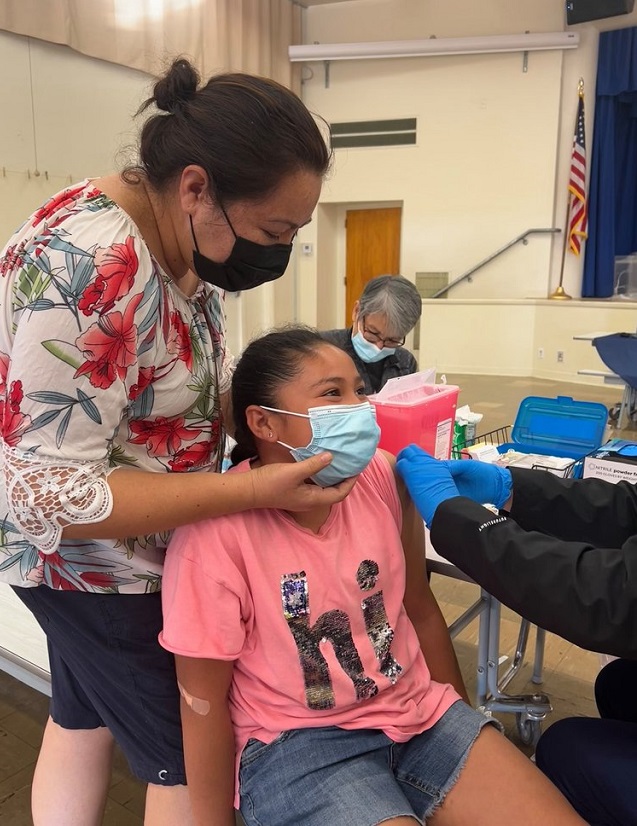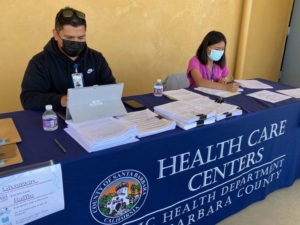Bringing Together County and Community Expertise to Stem COVID-19
Program
-
Focus Areas
Communicable Disease Prevention -
Expertise
Coalition & Network Building -
Strategic Initiatives
COVID-19, Vaccine Access & Equity

When most people think of Santa Barbara, they often picture palm trees and the Pacific coastline, seafood restaurants and maybe even Oprah, a well-known denizen. But the County of Santa Barbara, with a population of almost 450,000, is much more varied and diverse than its most recognizable town.
So when the Santa Barbara Public Health Department (PHD) and its staff began their plans to combat the COVID-19 pandemic, they knew they would need to closely partner with leaders in communities across the region, to reach everyone from rural agricultural farmworkers to the historically underserved Black population.
“We knew that there were already many organizations on the ground who were trusted messengers, who knew where the gaps were,” said Timothy Watts, MPH, Health Equity Coordinator of the Santa Barbara Public Health Department. “Working with and trusting these community experts was crucial in reaching our large and widespread population, while allowing the county to focus on what we can do best.”
We knew that there were already many organizations on the ground who were trusted messengers, who knew where the gaps were. Working with and trusting these community experts was crucial in reaching our large and widespread population, while allowing the county to focus on what we can do best.Timothy Watts, MPH
Health Equity Coordinator of the Santa Barbara Public Health Department
The Together Toward Health (TTH) model is built around the power of this kind of cross-sector collaboration, bringing together community-based organizations (CBOs) and local government agencies to share their respective expertise and reach the wide diversity of Californians. Santa Barbara’s successes are a testament to what is possible when grassroots CBOs and public health teams combine their strengths.
From the beginning of TTH’s efforts in Santa Barbara, the local health department was deeply involved and supportive, helping identify potential grantees that could most benefit from TTH’s flexible funding and collaborative approach, and actively engaging in monthly grantee meetings. The group of seven CBOs and the health department took the time to build trust with each other, having honest conversations about what was working and what was needed, exchanging ideas rather than prescribing specific tactics.
 Through these conversations, the county was able to provide critical support that small organizations did not have access to or capacity for, from parsing in-depth data reports to creating materials. For example, Lawanda Lyons-Pruitt, president of the Santa Maria-Lompoc NAACP, the only organization in the county that focused on the Black community, became a close and vocal partner—making it clear when the health department wasn’t effectively reaching African-Americans. So, when she told the group she needed flyers that represented her community, the department team went to work designing and printing one in a few days, and joined with Lawanda to distribute them at a local Black church. Though creating flyers may seem like minor support for a large organization, for a small and very busy one like Lawanda’s, it freed up valuable time for building relationships and conducting outreach.
Through these conversations, the county was able to provide critical support that small organizations did not have access to or capacity for, from parsing in-depth data reports to creating materials. For example, Lawanda Lyons-Pruitt, president of the Santa Maria-Lompoc NAACP, the only organization in the county that focused on the Black community, became a close and vocal partner—making it clear when the health department wasn’t effectively reaching African-Americans. So, when she told the group she needed flyers that represented her community, the department team went to work designing and printing one in a few days, and joined with Lawanda to distribute them at a local Black church. Though creating flyers may seem like minor support for a large organization, for a small and very busy one like Lawanda’s, it freed up valuable time for building relationships and conducting outreach.
The county team, led by Dr. Van Do-Reynoso, also provides key data updates in every TTH Santa Barbara meeting, translating the dense mass of county-wide information and numbers into important metrics that the CBOs can act upon, and importantly, take encouragement from.
Seeing the numbers of vaccinations rise in the ZIP codes that our partners have been doing outreach in is a great way for us to see our progress, especially when things get hard. And I love translating the data into something that’s useful for all levels of our community, and using it to strategize together about what we need to do next and who else we need to reach.Stefanie Hernandez
Health Educator with the Santa Barbara Public Health Department
And of course, as a partnership, the support goes both ways. Mixteco Indigena Community Organizing Project (MICOP), a grassroots organization that serves the almost 35,000 Indigenous residents of Santa Barbara County, did vital work in reaching this large and disproportionately vulnerable population—and they ensured that the county was able to create culturally and linguistically appropriate information to serve the Mixteco, Zapotec, and Purépecha communities.
“Early on, there were so many communities that didn’t have access to good information and we knew we needed better translation,” Stefanie explains. “Working with MICOP to create materials and videos in Mixteco was so important in ensuring language justice, especially for the under resourced farmworker communities that were hardest hit by the pandemic.”
 Beyond the incredible work that the Santa Barbara collaboration has accomplished in battling COVID-19, the group is now looking ahead to broader public health and health equity goals. In April 2021, the Santa Barbara County Board of Supervisors passed a resolution declaring racism as a public health emergency, paving the way for a new initiative, the Health Equity Alliance. Along with all the TTH grantees, the Public Health Department will be bringing in more diverse partners to the table to collectively tackle the racial and health disparities made even clearer by the pandemic.
Beyond the incredible work that the Santa Barbara collaboration has accomplished in battling COVID-19, the group is now looking ahead to broader public health and health equity goals. In April 2021, the Santa Barbara County Board of Supervisors passed a resolution declaring racism as a public health emergency, paving the way for a new initiative, the Health Equity Alliance. Along with all the TTH grantees, the Public Health Department will be bringing in more diverse partners to the table to collectively tackle the racial and health disparities made even clearer by the pandemic.
“Together, we’ve learned and accomplished so much over the past two years, but we know there are still gaps to close, capacity to build, and space to share,” said Timothy. “I’m looking forward to bringing what we’ve learned about flexibility, true partnership, and community expertise to this new alliance.”
This impact story was first published on the Together Toward Health site.
Work With Us
You change the world. We do the rest. Explore fiscal sponsorship at PHI.
Support Us
Together, we can accelerate our response to public health’s most critical issues.
Find Employment
Begin your career at the Public Health Institute.
